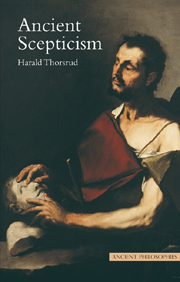Book contents
- Frontmatter
- Contents
- Preface
- Sources and abbreviations
- Chronology
- 1 Introduction
- 2 Pyrrho and Timon: the origin of Pyrrhonian Scepticism
- 3 Arcesilaus: the origin of Academic Scepticism
- 4 Carneades
- 5 Cicero: the end of the sceptical Academy
- 6 Aenesidemus: the Pyrrhonian revival
- 7 Sextus Empiricus: the consistency of Pyrrhonian Scepticism
- 8 Pyrrhonian arguments
- 9 The (ordinary) life of a Pyrrhonist
- Notes
- Guide to further reading
- References
- Index of passages
- Index
1 - Introduction
- Frontmatter
- Contents
- Preface
- Sources and abbreviations
- Chronology
- 1 Introduction
- 2 Pyrrho and Timon: the origin of Pyrrhonian Scepticism
- 3 Arcesilaus: the origin of Academic Scepticism
- 4 Carneades
- 5 Cicero: the end of the sceptical Academy
- 6 Aenesidemus: the Pyrrhonian revival
- 7 Sextus Empiricus: the consistency of Pyrrhonian Scepticism
- 8 Pyrrhonian arguments
- 9 The (ordinary) life of a Pyrrhonist
- Notes
- Guide to further reading
- References
- Index of passages
- Index
Summary
The Greek word skepsis means enquiry or investigation. But a sceptic is not merely one who investigates; almost everyone does that. Sceptical investigation is distinctively shaped by the possibility of deception and error; and it is an important corrective to our credulous and sometimes gullible inclinations. In this book we shall examine the two philosophical movements – Pyrrhonian and Academic – that stretch from approximately the third century bce to the second century ce and together constitute ancient Scepticism.
Both Academic and Pyrrhonian Scepticism develop in complicated ways in response to each other and in response to their common dogmatic opponents. In order to trace these lines of historical influence and development, I present the Sceptics in the following chapters in chronological order (with the exception of Chapters 5 and 6). While it would be misleading to describe the whole of ancient Scepticism as a unified philosophical movement, the ancient Sceptics do share some family resemblances. As a general introduction, I offer a brief characterization of common argumentative strategies and concerns followed by a sketch of the historical narrative to be developed and some remarks about the distinction between Academics and Pyrrhonists.
Suspension of judgement
By the time the Sceptics arrived on the scene there were many competing and incompatible philosophical theories available. One of the central preoccupations of Greek philosophy from the Presocratics onward was to account for the variability and deceptiveness of appearances, and more generally to explain how and why things change.
- Type
- Chapter
- Information
- Ancient Scepticism , pp. 1 - 16Publisher: Acumen PublishingPrint publication year: 2008

